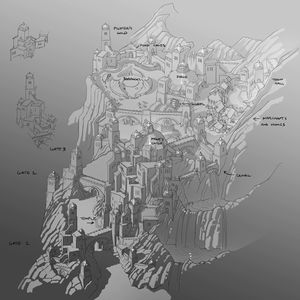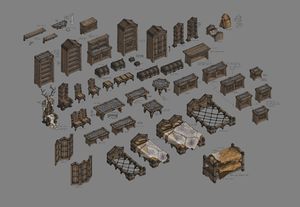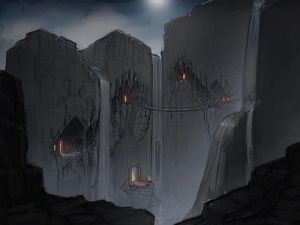The original article was posted here on October 27, 2015.
Within the white peaks of Wrothgar lies Orsinium, a battered snow-covered city that has survived solely on the resilience of its people. You'll learn all about the Orcs and their struggle to come together and rebuild their once-great home in the upcoming Orsinium DLC game pack, our second DLC for The Elder Scrolls Online: Tamriel Unlimited. To help you prepare for your adventure into the Orc stronghold, we'd like to share some details about our process for creating ESO's newest zone, a region unseen in The Elder Scrolls series for nearly twenty years.
As we started preparing for the creation of the zone, our art team spent a lot of time reviewing the lore behind both Wrothgar and its capital Orsinium, a city last seen in The Elder Scrolls II: Daggerfall. Orsinium was known as the “Iron City" in lore, something we took quite literally in our initial concepts. After some iteration, we adapted the term “Iron City" to refer to the defensibility of the area, instead of focusing on a cube-shaped iron design. After going through a series of carefully reviewed design drawings, we began working on a 3D model of what the zone should look like, which gave our development team a basic blueprint to work with.
For reference, the city itself is similar in size to Daggerfall, despite feeling much bigger due to vertical design. From an art direction, the desire was to create a city with a modular design featuring different elements that would come together to form a look unique to the game. One of the main differences between Orsinium and other cities found within ESO is the verticality of city. You'll notice how neatly the structures are stacked on top of each other as they rest on the mountainside. Many of Orsinium's buildings were even carved into the mountains, so where previously the interiors were single pieces that felt very similar, the inner mountain interiors offer a distinct visual look and feel, different than anything you've seen previously.
While our stacking approach made for an interested aesthetic, piling so many buildings all vertically lined within a small surface area caused us to completely max out the amount of polygons that that one area could hold. There's a ton of assets packed within such a small space, including buildings, mountains, weather effects, and all of the props used to flesh out of the area. There are also multiple states of Orsinium since the city is being rebuilt throughout your playtime, and each stage of the rebuilding process takes up polygons. The texture memory quickly reached its limit due to the complexity of the environment. Our development team joked that adding even one additional apple to the zone would push it past its technical limits.
While making progress on determining the layout of the zone, the structures within Wrothgar were tweaked throughout development. Our original city design used dome shapes extensively as tower and building caps, but concerns about polygon usage were brought up during review. In response, we used the same structural roofing as the traditional Orc houses, which featured an angular profile. Using the same line language made it easy for us to reuse Orc props that were previously created, which ultimately helped with the look of the area to be more Orc-like, while reducing the overall polygon count.
After finalizing the structural design, we began adding the detail work as part of the world building process. You'll notice that there's a lot of fur and other “Orc weirdness" within the interior structures to make the area standout so it wouldn't be confused with traditional Breton architecture. This included creating an entire line of Orc furniture, everything from dressers, to chests, to beds topped with fur. Internally, we jokingly used the term “Or-KEA" to refer to our large collection of Orcish furnishings. You can see from the image below that these pieces are bold and rugged, tough enough to match the Orc personality type, while also clearly crafted by artisans. It's that perfect mix that also helps capture the essence of the Orc people.
As you follow the story of the main questline, you'll learn that the Orcs are a strong group, and while they don't often join forces, they've come together for the common goal of rebuilding their once great home. A story element that remained throughout the early renderings was the emphasis that the city has been destroyed and rebuilt several times, which needed to be clear both from the story and from a visual standpoint. Since this is a key story point, we thought it would be really powerful to have you feel as though you are helping with the rebuilding of the city. As you work to complete the main storyline, you'll notice that the desecrated architecture starts to appear rebuilt.
We also wanted to make sure that we offered you the freedom to complete content in the order you want. So while the city is being rebuilt as you progress through the content, specific quests are not linked to the reconstruction efforts. We wanted the rebuilding of Orsinium to feel more organic, so it's occurring along your journey instead of being the result of your actions. Between the main and side quests, you're able to pick up and play through the quest content however you want--and there's a lot of it to complete, too. There are quest pins everywhere.
(The video can be found here.)
In order to best show that the environment was changing as you progressed through the content, we initially had structural changes occur throughout the entirety of the zone. For instance, all of the lower scaffolding would start to appear at the same time. We found that these changes were too gradual, and not as noticeable as we desired during our internal playtests. We decided to break the area up into districts so that visual structural changes were apparent as soon as they happened within a set region. So as you're progressing through the residential region, you'll notice that the construction is progressing along with your time completing the story.
One hurdle that we needed to conquer was collision, a design mechanic that prevents the player from walking through buildings or other structures. Since the city will appear in different states to each player depending on their progress through the content, we needed to keep the collision footprint the same for the base of each structure and to only have the upper portions change drastically—you'll still be in the world with other players, you'll just see that world differently. So while some lower level changes occur, like changing a pile of wood into a stall, the majority of changes occur off the ground level. This created another issue: getting players to look upward at those structural changes. In general, getting players to look up in game development is quite a challenge, and with Orsinium being a vertically inclined city, it was a must. Being built within tall mountains helped, as did adding weather effects like snowfall.
We also pulled back the fog, which is commonly found in the distance of larger zones, so you're now able to see more of the area. This was in large part due to newly added technology that allowed us to show more trees, mountains, and environment structures than ever before. We also created levels using stairs that helped add height to the structures. We also added many scenic outlooks throughout the zone. If you see a ledge in the distance, we wanted you to be able to get to it and explore, while taking in the sights of the mountains.
At one point, we actually had NPCs that you could see far in the distance on the mountains. We removed them to clean up the design, and because of the strain these added resources put on our tech. We found that the background environment would sometimes load after the NPCs themselves, so instead of standing on the mountains you'd see them spawning, then quickly falling to their deaths before the mountains could render. Removing them saved us some polygons, and prevented an unsightly wave of accidental NPC cliff diving.
At its completion, the zone of Wrothgar became the biggest piece of new content that we've created since launch. Usually when creating a new area for the game, there are multiple cities included in each zone. For Orsinium, we only needed one just based on the size alone. In fact, the dungeon of Old Orsinium is one of the largest playable areas that we've created to date. We aimed to create a rich, compelling story that explores the rebuilding of the Orc capital and in doing so, we recorded a ton of new voice over work to help bring the characters' stories to life. We actually went way over our initial estimate for voice over work, but we think the end result was well worth it.
From start to finish, Orsinium has been a labor of love from our development team, crafted by our largest content team of developers to date. We can't wait for you to check out what we've created, and to experience the story of the Orcs for yourself. The Orsinium DLC game pack for ESO releases for PC/Mac on November 2, Xbox One on November 17, and November 18 for PlayStation®4.




